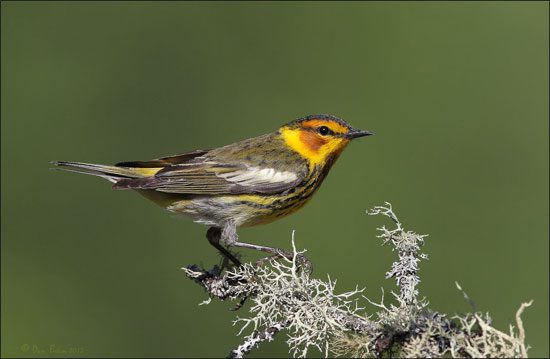Originally published in the Spring 2013 issue of Living Bird; updated May 2024.
Spring is a prime season for birdwatching. Many birds are easier to identify in their brightly colored breeding plumage. Males sing with increasing frequency as they approach their breeding grounds. And bird flocks become quite concentrated during migration, with large numbers of each species passing through in the brief space of a few weeks.
But that doesn’t mean birdwatching is easy in spring. Most migrants don’t visit backyard bird feeders. Finding those jewels of migration, such as Blackburnian Warblers, Cape May Warblers, and Townsend’s Warblers, usually requires getting out and birding in the field. There are several ways to improve your chances of striking warbler gold this spring.

Study habitat clues
During migration, many songbirds aren’t as finicky about their habitat preferences as they are when they’re breeding. For some birds, any place with available food and shelter will do for a pit stop during spring migration. Take the Blackpoll Warbler, which breeds strictly in spruce-fir forests but during migration can be found in a cluster of willows or in a small patch of cottonwoods. Other birds stick to their favorite habitats. Common Yellowthroats always prefer low wet areas, and Cape May Warblers maintain their strong preference for spruces.
Think big and small
When plotting your spring birdwatching, consider both broad habitats and microhabitats. Broad swaths of forested of land, such as those found in the mountains or in river valleys, can be fantastic during migration, because they provide large areas of great habitat to support many hungry migrants. On the other hand, a microhabitat is an anomaly on the landscape that will suck in migrating birds crossing a big area devoid of safe places to stop, rest, and eat. It could be an isolated patch of trees on the plains of Colorado or a tree-studded island in Lake Superior. City parks can be incredible spots for finding warblers, because they may only have a small patch of trees where the birds can land.
Head for the hills
Elevated areas often draw large concentrations of birds, because they’re closer to the cruising altitude of migratory birds, and they tend to be the first sites warblers land when they drop down from nighttime migration. A park at the top of a hill in a city, such as Garret Mountain Reservation on the outskirts of New York City or Mount Auburn Cemetery in Boston, can be a fantastic place to find warblers.
Watch the weather—and Use BirdCast
Picking the right day, with the right weather conditions, can make all the difference in what you see. In the spring, warblers move on winds blowing from the south. South winds help push migrants toward their northern breeding grounds, which allows the birds to expend less energy. But for a birdwatcher, sustained south winds may cause birds to fly right over without stopping in your neighborhood. Watch your local forecasts for storms that force migrating birds out of the air and down to patches of habitat. The largest concentrations of birds and fallouts generally occur when south winds are met by some change in the weather—rain, snow, or a quick shift in wind direction. Even a passing line of local thunderstorms can leave an astonishing array of avian gems in your local park. Check quickly, though, because the birds will often depart the next night.
During both spring and fall migration, BirdCast creates 3-day forecasts of migration intensity for the contiguous United States—giving you an idea of when weather conditions will come together for heavy nights of migration. They even have a Migration Dashboard that can estimate how many birds are flying over your county or state each night. Here’s a primer on how to use Migration Dashboard and other BirdCast features.
Use your ears—and Merlin Sound ID
As warblers push north on their mad dash to their breeding grounds, the frequency of their singing and level of intensity increases. Listening for bird songs and short call notes can be a great way to find an unexpected bird. You don’t need to be an expert at birding by ear. Simply listen and try to track down any songster uttering an unusual vocalization.
Or try Sound ID from your Merlin Bird ID app—it can identify the songs or calls of more than 1,300 species in the Americas, Europe, and India, to give you an idea of what might be in the treetops around you. Give it a try—you might just find that what you thought was a variation of a Black-and-white Warbler’s squeaky-wheel song is actually a Bay-breasted Warbler.
If you’re not quite sure which migrants are arriving where or when, use the bar charts (under the “Explore Data” tab) on eBird.org. Select your state and county, then click on the month at the top of the bar chart, and you can see how frequently each species occurs in your area, down to the week. You can also check BirdCast for real-time bird forecasts that track the waves of migrants moving north across the continent. Armed with the latest intelligence on bird movements, and a plan for finding your local migrant bird hotspots, you just might have your best spring birdwatching season ever.

